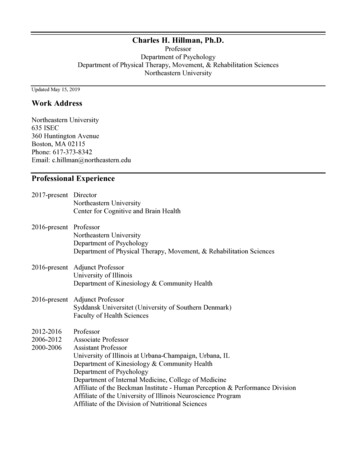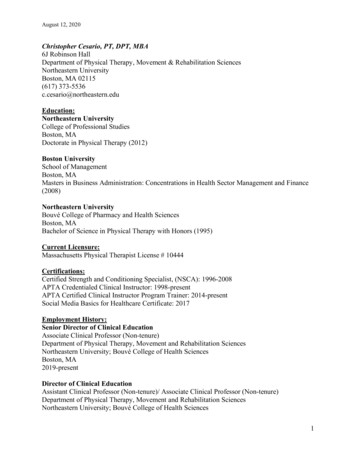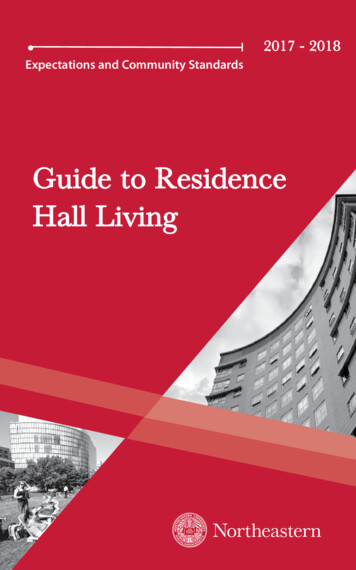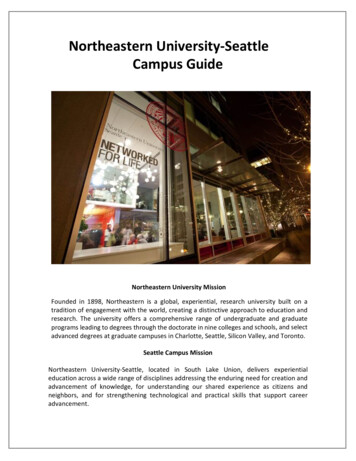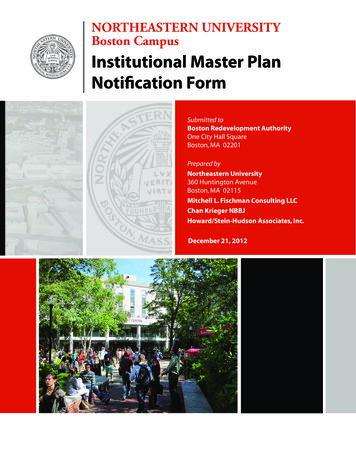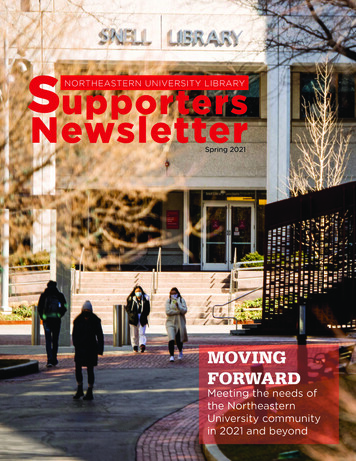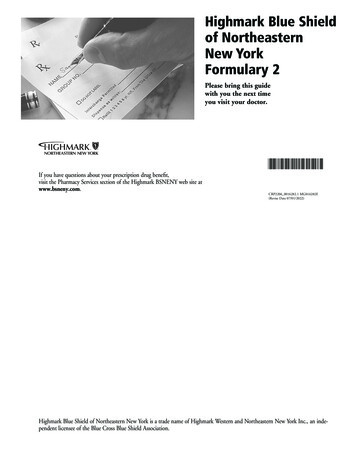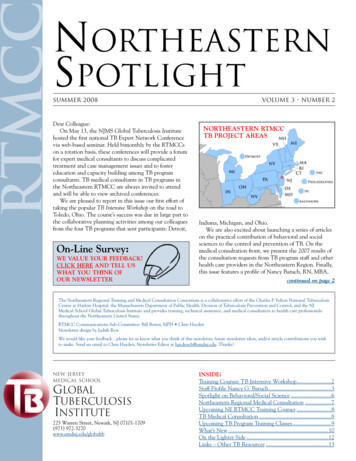
Transcription
RTMCCTABLE OF CONTENTSNORTHEASTERNSPOTLIGHTSUMMER 2008Dear Colleague:On May 13, the NJMS Global Tuberculosis Institutehosted the first national TB Expert Network Conferencevia web-based seminar. Held bimonthly by the RTMCCson a rotation basis, these conferences will provide a forumfor expert medical consultants to discuss complicatedtreatment and case management issues and to fostereducation and capacity building among TB programconsultants. TB medical consultants in TB programs inthe Northeastern RTMCC are always invited to attendand will be able to view archived conferences.We are pleased to report in this issue our first effort oftaking the popular TB Intensive Workshop on the road toToledo, Ohio. The course’s success was due in large part tothe collaborative planning activities among our colleaguesfrom the four TB programs that sent participants: Detroit,On-Line Survey:WE VALUE YOUR FEEDBACK!CLICK HERE AND TELL USWHAT YOU THINK OFOUR NEWSLETTERVOLUME 3 NUMBER 2NORTHEASTERN RTMCCTB PROJECT AREASIndiana, Michigan, and Ohio.We are also excited about launching a series of articleson the practical contribution of behavioral and socialsciences to the control and prevention of TB. On themedical consultation front, we present the 2007 results ofthe consultation requests from TB program staff and otherhealth care providers in the Northeastern Region. Finally,this issue features a profile of Nancy Baruch, RN, MBA,continued on page 2The Northeastern Regional Training and Medical Consultation Consortium is a collaborative effort of the Charles P. Felton National TuberculosisCenter at Harlem Hospital, the Massachusetts Department of Public Health, Division of Tuberculosis Prevention and Control, and the NJMedical School Global Tuberculosis Institute and provides training, technical assistance, and medical consultation to health care professionalsthroughout the Northeastern United States.RTMCC Communications Sub-Committee: Bill Bower, MPH Chris HaydenNewsletter design by Judith RewWe would like your feedback please let us know what you think of this newsletter, future newsletter ideas, and/or article contributions you wishto make. Send an email to Chris Hayden, Newsletter Editor at haydench@umdnj.edu. Thanks!New JerseyMedical SchoolGlobalTuberculosisInstitute225 Warren Street, Newark, NJ 07101-1709(973) 972-3270www.umdnj.edu/globaltbINSIDE:Training Courses: TB Intensive Workshop.2Staff Profile Nancy G. Baruch.3Spotlight on Behavioral/Social Science .6Northeastern Regional Medical Consultation .7Upcoming NE RTMCC Training Courses .8TB Medical Consultation .8Upcoming TB Program Training Classes.9What’s New .10On the Lighter Side .12Links – Other TB Resources .13
TRAINING COURSES2NORTHEASTERN SPOTLIGHTSUMMER 2008TB Intensive Workshop – On the RoadFor the first time, our popular TBIntensive Workshop was taken on theroad in April 2008! This provided anopportunity for local health careproviders to participate in a course theymight otherwise not have been able toattend. During the 2007 National TBController’s Association Meeting, TBPrograms from Indiana, Michigan, Ohio,and the city of Detroit identified theneed for a regional clinical intensivetraining. Toledo, OH was chosen as thetraining site because of its centrallocation and ease of access for the fourThe major strengths of thecourse were the contentexpertise of the faculty, thetopics covered, and theinteraction offered by thecase studies.TB programs involved.Months of planning – seven to beexact – through numerous emails, conference calls, and individual phone callshelped to make this vision a reality. It wasthrough this extensive – and gratifying –planning process that we became betteracquainted with our colleagues in theMidwest: Linda Burbank and MelindaDixon (Detroit), Shameer Poonja andSarah Burkholder (IN), Peter Davidsonand Gail Denkins (MI), and MaureenMurphy (OH). This was truly acollaborative experience that helped tofoster a stronger relationship between theRTMCC and each of the TB programs.Using the RTMCC core course as amodel, a TB Intensive Workshop wasdeveloped with input from the four TBprograms to address the needs ofclinicians currently managing TB patientsin this geographic area. Topics includedstandard themes such as transmissionand pathogenesis, treatment for LTBIand TB disease, TB-HIV co-infection,MDR-TB, and TB in children andadolescents. In addition, the followingspecial topics were covered: lessonslearned from local outbreaks, a review ofchanges in local epidemiology and TBtrends, and TB among immigrants andrefugees with an outline of new information in the 2007 Technical Instructionsfor Panel Physicians. A clinical discussionof several cases was included to integratelecture component with practicalexperiences in treating and managingTB. In order to draw on existing TBknowledge and local expertise in thisregion, the TB medical consultant fromeach program served as faculty for thistraining. Additionally, faculty membersfrom various specialties were chosenfrom state and local TB programs,universities, and schools of medicine.The two-day workshop, held onApril 17-18, 2008, was attended by atotal of 39 physicians and nurses from avariety of workplace settings, includinglocal health departments, hospitals,private practice, correctional medicalservices, community health centers, andcollege health centers.Feedback about the course was verypositive. Based on the informationprovided during the training, manyparticipants stated they anticipate makingchanges in their practice, including: Review and revise current policiesthat impact standards of TB care Improve targeted testing practices forvarious patient populations Assess the way in which resources areallocated for TB Develop strategies for convincingpatients to accept treatment of LTBIand complete therapyAs a result of the course, there wasan overall increase in knowledge aboutTB. Specifically, participants were betterable to define the difference betweenLTBI and TB disease, identify drug-druginteractions of rifamycins in thetreatment of TB-HIV co-infectedpatients, list the environmentalcharacteristics to consider duringcontact investigations, and understandhow TB affects adults differently thanchildren and adolescents.The major strengths of the coursewere the content expertise of thefaculty, the topics covered, and theinteraction offered by the case studies.Members of the planning committeementioned that participants from theirarea found the workshop to be helpful,comprehensive, and provided anopportunity to network with colleagues.Members of the planning committeeand several course participantsmentioned that this training should takeplace on a yearly basis. Truth be told, wewould happily do it all over again. Infact, there are plans to offer a similartraining for a different target audiencein Fall of 2009 that would take place inthe same geographic region.Submitted By Anita Khilall, MPHTraining and Consultation SpecialistNJMS Global Tuberculosis InstituteDear Colleaguecontinued from page 1TB Controller for Maryland, who is regionally and nationally recognized as a leaderin TB control efforts.And, as usual, if you have any feedback for any of us, on any TB related topic, Iinvite you to contact me or a member of our RTMCC staff at (973-972-3270).Lee B. Reichman, MD, MPHExecutive DirectorNJMS Global Tuberculosis Institute
STAFF PROFILE3NORTHEASTERN SPOTLIGHTSUMMER 2008Staff Profile: Nancy G. Baruch, RN, MBACHIEF, DIVISION OF TUBERCULOSIS CONTROL, REFUGEE & MIGRANT HEALTH,MARYLAND DEPARTMENT OF HEALTH & MENTAL HYGIENE (DHMH).(Left to right, back row) Adam Palmer (Refugee Health), Maureen Donovan, Cathy Goldsborough, Heather Rutz (TBESC), Tori Miazad, Dipti Shah(Refugee Health), Wendy Cronin (TBESC), Mark Miner (CDC Sr. PHA); (left to right, front row) Lien Nguyen, Nancy Baruch, Arlene Hudak, VickiRandle; (not in photo) Sandra Matus.Growing up in Michigan, NancyBaruch became seriously interested inpursuing a career in healthcare,especially after reading an autobiographyof Dr. Tom Dooley in elementary school.Growing up in a family of nurses(grandmother, mom, a couple aunts) andworking as a nursing assistant at thelocal hospital while in high school(where she observed it wasn’t thedoctors, but the nurses, who really madethe difference in outcomes for mostpatients), she opted for a career innursing. It first occurred to Nancy topursue public health after doing a publichealth rotation during her senior year.She liked the independent thinkingpublic health required, the myriadchallenges, and the fact that in publichealth nursing you met lots of interestingpeople. She especially liked the respectand appreciation of clients when theymet someone they felt cared. “Let’s faceit, what public health nurses and outreachworkers do in the field makes or breaks aTB program.” Maryland has been herhome since she was a young adult.Nancy’s career in tuberculosiscontrol presented itself more or lessserendipitously. “I had worked manyyears in the hospital setting as clinicalnurse, manager, educator, andadministrator. The opportunitypresented itself, I was looking forsomething new, and yes, I had awonderful TB mentor, Sarah Bur. Shewas visionary, dynamic, committed,enthusiastic, and a great teacher for me.From her, I learned that the function ofstate program staff is to support whatlocal jurisdictions are doing. If you aretoo focused only on what you want toget accomplished, it won’t work. Statelevel staff need to be cognizant that theyare generally not out in the field doingthe work of TB control. State programmanagers and staff exist to be of serviceto local health jurisdictions (LHDs), notthe other way around.”Nancy is now responsible for statewide programs related to TB, refugee,and migrant health; she overseesfunding, education and trainingprograms, and local program adherenceto established guidelines for all threeprograms. All this happens only with thesupport of a wonderful team includingtwo nurse consultants, a refugee healthcoordinator, one full-time and one parttime epidemiologist, one surveillancedata manager for TB, one epidemiologistfor refugee health, along with program,fiscal, and secretarial support staff. TheTB program was, until recently, alsosupported by a Senior Public HealthAdvisor assigned from CDC. Whilemuch of the programmatic structure wasinherited, the ability to maintain it hasbeen key to providing LHD support. Inaddition, the TB EpidemiologicalStudies Consortium (TBESC) staffreport through this Division; DHMH isCo-Principal Investigator on the TBESCproject in Maryland, partnering withBaltimore City and the Johns HopkinsSchool of Medicine. Nancy noted, “I amvery proud of our state being selected asa TBESC site and the participation ofboth DHMH consulting and surveillancestaff on various CDC TB workgroups.Encouraging staff to participate innational workgroups has strengthenedour program in many ways, and also putsme in a better position to negotiate theirtravel to national meetings whenrestrictions are imposed.”Reflecting on her career, she adds,“So far it has been a fantastic learningopportunity and I continue to learn allthe time. I have been, and continue tobe, impressed with the extraordinarywork done by my colleagues in the field.I have seen TB in Maryland becomelargely a disease of the disenfranchisedand the foreign-born, which presentscontinued on page 4
Staff Profile4NORTHEASTERN SPOTLIGHTStaff Profilecontinued from page 3unique challenges and demands.When I first started working in thisfield, TB was still largely a disease of theelderly, infected much earlier in life; butthat no longer is the case. Populationsplagued by substance abuse and HIVnow contribute to the high TB rates, aswell as immigrant populations. As aresult, local health departments havehad to make many adjustments. Eventhose jurisdictions with long-standingmulti-cultural and multi-lingual staff arenow caring for populations unknown tomost of us a decade ago, e.g., the SomaliBantu.”What is Nancy like as a person?“I tend to be pretty quiet, but enjoybeing with family and friends. I also tendto be fairly patient, but don’t have muchtolerance for the foolishnessbureaucracies often create, and that canmake working in a government jobtricky at times. I wish we were notspending so much of our nationalresources on war. I wish we were notletting the fear of some potential ‘event’drive public health resource decisions tosuch a large extent, versus dealing withthe disease and want that already exists.”Outside of work, she says “I enjoytheater, opera and symphony. I love togarden, although I am somewhat limitedby a postage stamp size yard. I like toread especially history. I enjoy visitinglocal art galleries and museums. I love tovisit the ocean when I can. And I like towander through antique and junkstores—amazing things can be found!”What are some of the top educationand training priorities that you areworking on right now?“We are discussing how to provide formore advanced TB training beyond thebasics. This is in response to requestsfrom previously trained, seasoned staff –LHD nurses and doctors – who need sortof a TB 201, beyond basic TB 101training. We are discussing this with ourRTMCC and hope that the effort willhelp keep some local docs interested andon board with TB control. We are alsoplanning for the introduction of the newRVCT and national TB reporting systemSUMMER 2008(NEDSS TB–PAM) and for ourstatewide annual meeting in the Fall. Weare finalizing our skin test trainingschedule which offers a series of trainingsstatewide following the academic yearcalendar; instruction will be provided bya nurse we contract with through a longstanding agreement between DHMHand a local community college.”Maryland has a well-developed internaltraining capability in the area of TB.What are your expectations and visionfor TB education and training that willbe provided by the MD StateDepartment of Health?“Our state has a long history ofsupporting local TB Control programstaff. We have been fortunate in ourability to gain and keep the necessaryfunding to support nurse consultant staffthat work closely with local programsand who are able to identify and respondto training needs, including on-site oneon-one training if needed. We have beenextremely fortunate to be able to tapinto the expertise and experience oflocal academic faculty who have aninterest and background in TB; and wehave been lucky in being able to workwith a small, but critical, core group oflocal physicians who support our largerlocal TB programs.”How can we plan for who will run TBcontrol in the future, as the currentgeneration of TB leaders retires?“We need to be more involved in‘selling’ public health. In the past wecould always recruit good people fromlocal level positions; and as staff movedup, new graduates and peopleexperienced in other public healthprograms took their place. Today, peoplefeel public health does not pay enoughor offer enough opportunities forprofessional growth. We need to getinvolved in pre-service education inschools to promote careers in publichealth, but also need to advocate forbetter salaries and professional growthopportunities.”The population of Maryland includeshigh risk groups that other states alsoserve: rural poor, migrant workers, andinner city. What are the challenges youface in controlling TB in thesepopulations? How do you make sureyour programs are effective?“Availability of local resources isincreasingly problematic. We emphasizetreatment of cases to completion whenthey occur and have worked to improvecontact investigations and treatment tocompletion of high-priority contacts.More and more jurisdictions are using 4months of rifampin for the treatment ofLTBI in individuals who are transient forvarious reasons. We have limited statefunds to support incentives and enablers;and most of that money is now going towhat I would call enablers—for example,supplementing county funds to paysomeone’s rent for a couple months untilthey can return to work. We continue toreceive state funds to support thepurchase of TB medications for all localhealth departments. DOT is thestandard of care with support for its useencoded in state regulation.”As part of the DHMH’s Office ofEpidemiology and Disease ControlPrograms, Nancy’s staff participate inLHD site reviews every 18 months (ormore often if needed) where a formalreview of local TB programs takes place.They use this opportunity to supportlocal staff concerns during theirsummations and in the formal write-upsto local health officers. For example,continued emphasis to local healthofficers on the importance of decreasinglocal TB staff time committed to TBtesting for “political” versus publichealth reasons has had some measure ofsuccess.They also assist local staff dealingwith migrant populations to connectwith national TB organizations and havebeen able to support very limitedtargeted testing in some jurisdictions.Working with Baltimore City, theyparticipate in a special workgroup set upto deal with the ongoing outbreak in thecity’s homeless population. They wereable to provide state TB funds to assistwith the purchase of HEPA units for thelarger City shelters, and supported anaggressive campaign by the City TBprogram to educate shelter staff aboutTB and basic case-finding techniquessuch as the use of cough logs. “Use yourdata and share it with the localjurisdictions. A standard session at ourannual meeting includes a presentationcontinued on page 5
Staff Profile5NORTHEASTERN SPOTLIGHTStaff Profilecontinued from page 4of how the state has done in meetingnational TB program objectives andwhere we need to focus our attentionover the next year.”What do you find helpful in makingyou an effective trainer/educator?“I think it is important to have indepth discussions about what formaltraining content should include in termsof identified needs, so you can take theinformation and make it pertinent tothose you are trying to reach. Youcannot teach effectively from algorithmsalone. Being aware of local programdifferences is important. Timing iseverything–for example, we routinely askourselves if we might potentially beconflicting with flu clinic seasonactivities or pandemic flu exercises.Small regional meetings have beensuccessful and are well received by localstaff, but costs associated with travel maylimit our ability to do them frequently.Conference calls and video-conferencingcan also be effective means of getting themessage out.”“I encourage the use of the formalDHMH mechanism for notifying localTB staff about impending meetings,trainings, etc., because even though wecould communicate this information lessformally, I want the leadership at bothstate and local levels to be reminded ofTB and to be aware of new trainingbeing offered. This is a little more work,but keeps TB on everyone’s radar screen.We encourage local staff to share theirown experiences and have providedfinancial support for local staff to attendnational meetings and national trainingswhen we can. For example, this summerno one from our office will be able toattend the TB-ETN national meeting inAtlanta; but we recruited an activemember of our state’s program evaluationteam to represent us. We also give anannual award to recognize excellentwork in TB by an individual in thestate.”What about the value of training vs.technical assistance?“While formal on-going training isimportant, we have found that inSUMMER 2008jurisdictions where TB occurs rarely, youjust have to walk people through theprocess, be available for consultation,and make sure you keep in touchregarding follow-up.”“Take the time to learn what thelocal TB issues really are and make aneffort to address them. For example,even in a county that has not had a TBcase in years, there is probably a localdetention center that might be housingFederal detainees (a high-risk group);and perhaps that is a topic that shouldbe addressed. Or maybe you need toprovide the research information andprogram recommendations that localprogram staff can use to successfullyengage other local decision makers, e.g.,on the benefits of eliminatingunnecessary TB screening within thelocal schools. Ask people what they needto know and keep in touch – don’t besomeone they only hear from if thecontact data is not right or if you wantsomething.”How do you balance the ‘big picture’with the ‘day-to-day’ when workingwith LHDs?“It is always a struggle to determinethe best balance for formal training. Istrongly believe that people needexposure to the bigger picture, bothstatewide and globally, and to be at leastaware of the latest research.”“However, I also think we need to beable to give people what they need dayto day. If a jurisdiction is dealing withthe first TB case in a while and the nurseassigned is new, I would start by asking ifthey have current guidelines available –don’t assume they were left on the shelfby previous staff. Ask about the medicalprovider and if it would be helpful tohave a direct conversation with him orher. Ask if they have appropriate formsto document treatment and DOT.Review the standards of care and offer toassist with the contact investigation.Talk through their plans, as well as theircapacity to implement them. Keep thelines of communication open. If thewhole health department is in an uproar(e.g., related to a large contactinvestigation), get everyone who countsin on some of the initial conversations tohelp build trust. This is the type ofsupport DHMH nurse consultants offerroutinely to low incidence jurisdictions,as well as to the revolving door of staffassigned to work with TB in jurisdictionswhere nurses wear multiple hats andcross between programs. It is not formaltraining, but is critical to programsuccess; and I suspect very few TBprograms, including ours, do a very goodjob of documenting these activities.”“I often remind providers who don’tsee much TB that it is a very complexdisease, and that as far as I amconcerned, there is no such thing as astupid question. If I don’t know theanswer, I will do my best to find out andget back to people; and I tell them whento expect to hear from me.”“Don’t assume that people read whatyou send them. Assume the opposite. If Iwork in a rural setting dealing withmultiple programs and I get volumes ofguidelines and e-mails from all sorts ofstate and CDC programs, I will probablybe more inclined to read what ispertinent to what I have to deal withroutinely, versus what I may notencounter for months. This is a fact oflife that sometimes we tend to forgetfrom the perspective of a state office. Weneed to remember it and not be offendedwhen it occurs.”“I also think when TB is an unusualoccurrence, you need to be prepared tobe an advocate for the staff at the locallevel. If they are working with a localphysician who does not want to play bythe rules, offer to intervene or assistthem in a way that will preserve theirworking relationship. But do what ittakes to get the recalcitrant provider onboard with the plan of care.”What does the future hold?“I just read something the other daythat I think is important to keep inmind. The baby boomers (myselfincluded) learned their professionsdifferently than the generation of newproviders we are hoping to get interestedin TB prevention and control. The newgeneration of health department staffwill have grown up with computers, cellphones, I-pods, and other tools asroutine implements of daily living andwill expect to be able to use these toolsin their daily work to communicateinstantly with anyone, anywhere,continued on page 11
Spotlight6NORTHEASTERN SPOTLIGHTSUMMER 2008Spotlight on the Behavioral/Social ScienceContribution to TB ControlTuberculosis has long been viewed asresulting from the interplay of biologicaland social factors. In the late 19th andearly 20th centuries, popular belief andthe medical community approached TBas a ‘social disease,’ and emphasized thatthe environmental and behavioral basesof TB had to be addressed before a patientcould have a reasonable chance of beingcured. In fact, the emergence andevolution of TB sanatoria might beunderstood as a debate over how toadminister both the medical and thesocial cure for the disease. In morerecent times, some have suggested thatestablishing DOT as the standard of carecloses that debate prematurely, andsharply reduces the scope of the 'socialcure' to the creation of a temporarymechanism that ensures the medical cure.The 2001 Institute of Medicinereport, “Ending Neglect,” called for thecreation of “a program of research onbehavioral factors related to TBtreatment and prevention.” In response,the CDC’s DTBE convened theTuberculosis Behavioral and SocialScience Research Forum in December2003. There are several reasons why sucha research program could greatly assist TBcontrol efforts. With the overall declineof TB disease in US-born populations,TB is increasingly found in individualswith one or more major challenges suchas homelessness, substance abuse, ormental illness. Social and behavioralscientists and practitioners could helpTB controllers in understanding thesepopulations and devising effectivemeans of reaching them.Equally important is the persistenceof high TB rates among the foreign-born.Despite their minority status in the USpopulation, the foreign-born haverepresented the majority of cases withTB disease since 2001 and may representaround two-thirds of those being treatedfor Latent TB Infection. Theseindividuals originate in countries withwidely different TB beliefs and practicesfrom the US. Again, behavioral andsocial scientists can help in understanding these beliefs, leading to thedevelopment of methods to modifybeliefs and change behavior to achieveUS public health goals.Another important role for thebehavioral and social sciences is in thepromotion of treatment for Latent TBInfection (LTBI). As traditional TBcontrol efforts have focused on theidentification and treatment of activedisease, TB controllers have becomeaccustomed to having – though onlyusing as a last resort – the coercive powerof public health law to force individualsto comply with a TB evaluation, acceptDOT and complete treatment. Certainly,prudent TB programs have learned that“the carrot is better than the stick,” andlonger than that for active disease,other burdens related to long-termpill-taking, and the lack of positivebenefits from symptom relief?Both the TB control workforce andbehavioral/social scientists continue tostruggle with understanding andaddressing the medical and socialdimensions of the disease. We believethat an on-going dialogue between thesetwo groups will further the goals of bothTB control and behavioral/socialscience, and we hope that this series,‘Spotlight on the Behavioral/SocialScience Contribution to TB Control,’will contribute to that dialogue. Wewelcome your comments to the ideasBoth the TB control workforce and behavioral/social scientistscontinue to struggle with understanding and addressing themedical and social dimensions of the disease. We believe that anon-going dialogue between these two groups will further thegoals of both TB control and behavioral/social science.have placed more emphasis on enticinggood adherence than threatening direconsequences. Nevertheless, treatmentof active disease affords powers to TBcontrollers that are not available whenmanaging LTBI treatment.At the current time, completion ratesfor LTBI treatment are abysmal, far belowthe Healthy People 2010 goal of 85%.In standard clinical practice, LTBItreatment completion often falls below50%. Nationally, even among infectedcontacts to AFB-positive cases, onlyabout 70% start treatment for LTBI andamong these only 60% completetreatment. An improvement in LTBIcompletion rates will require a muchbetter understanding of patient beliefsand behaviors: What motivates an individual toaccept LTBI treatment despite conflicting information about its efficacyand the possibility of side effects? What motivates an LTBI patient tocomplete treatment despite a regimenexpressed above.In subsequent issues, we will explore: The role that behavioral and socialsciences have historically played inTB control; How behavioral/social scienceresearch informed HIV/AIDSinterventions and implications forTB prevention and control; Recent findings from TB behavioral/social science studies with practicalprogrammatic applications; and Upcoming findings from specific TBEpidemiological Studies Consortiumstudies having a behavioral/socialscience focus and how these might betranslated into practice.We welcome your comments andsuggestions on how this Spotlight seriesmight help to meet your needs.Submitted by Paul Colson, PhDProgram DirectorCharles P. Felton National TuberculosisCenter At Harlem Hospital
MEDICAL CONSULTATION7NORTHEASTERN SPOTLIGHTSUMMER 2008Northeastern RegionalMedical Consultation Service, 2007As an RTMCC, GTBI is tasked byCDC with strengthening medicalconsultation throughout the NortheasternUS. Toward this end, since 2005 theGTBI has provided expert medicalconsultation to TB program medicalconsultants and other health careproviders via 1-800-4TB-DOCS andemail. In conjunction with eachconsultation, community providers areencouraged to contact TB programmedical consultants with future requestsfor consultation. Educationally, GTBIhas convened annual TB MedicalConsultants Meetings for TB programmedical consultants in the NE Region;conducted bi-monthly web-based grandrounds at which TB program consultantspresent difficult cases and receivefeedback from colleagues; and providedtraining courses and webinars with acli
The Northeastern Regional Training and Medical Consultation Consortium is a collaborative effort of the Charles P. Felton National Tuberculosis . MBA, continued on page 2. T R A I N I N G C O U R S E S 2 NORTHEASTERN SPOTLIGHT SUMMER 2008 TB Intensive Workshop - On the Road For the first time, our popular TB . Executive Director NJMS .
